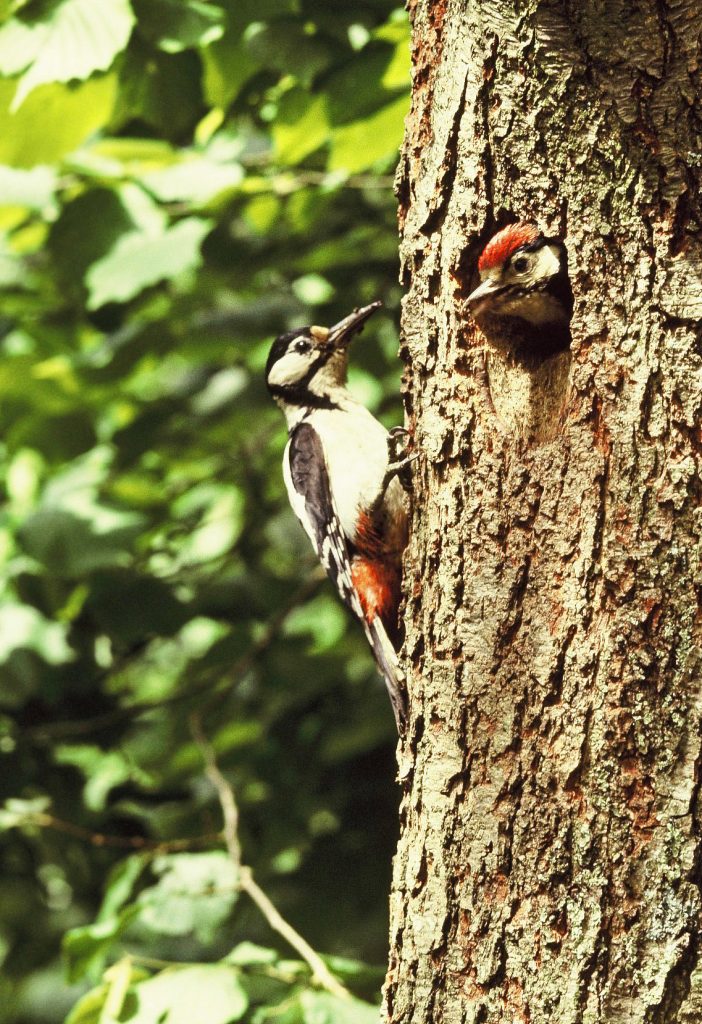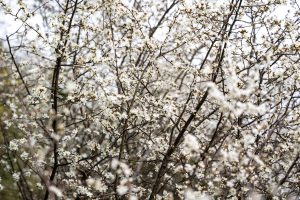Hammered home by Andrew Cooper
One of the most colourful characters that live on our farm here in Devon, is the great spotted woodpecker. While many birds go about their daily business almost unseen and unheard, this bird seems to want to be noticed. Their welcome spring drumming on a suitable hollow tree heralds their breeding season. Even when visiting our nut feeder they announce their presence loudly before arrival and then bash away noisily while extracting peanuts.
They also have some favourite trees in our woods. An old Scots pine has a series of holes down the trunk. Presumably as the centre slowly rots away the birds just hammer out a new doorway lower down. But it almost defies belief that they can enlarge a small hole in a seemingly healthy large ash tree. Yet they do and they are not alone.
The green woodpecker feeds principally on ants, or rather their grubs, and can frequently be seen in summer working their along the edge of our lawn. With a ridiculously long tongue, they feel their way down through the narrow tunnels to extract a meal. They too have a loud voice which is often said to herald rain. Indeed, so persistent is the call when wet weather is on the way, that I was once reliably informed by an elderly farmer's wife that it was the cry of the 'Rainbird', but she had no idea what it looked like! The lady took some convincing that it was actually a green woodpecker. But then their more common Devon name is 'Yaffle', the sound of their piercing cry.
The ability of woodpeckers to hammer out a home benefits many other creatures by providing a home for smaller birds, bats and even dormice. So when that hole is enlarged by wood rot, they can then be used by other larger birds, including kestrels and owls. So it is not just us that enjoy the presence of these brilliant, brash characters.
Andrew Cooper
They also have some favourite trees in our woods. An old Scots pine has a series of holes down the trunk. Presumably as the centre slowly rots away the birds just hammer out a new doorway lower down. But it almost defies belief that they can enlarge a small hole in a seemingly healthy large ash tree. Yet they do and they are not alone.
The green woodpecker feeds principally on ants, or rather their grubs, and can frequently be seen in summer working their along the edge of our lawn. With a ridiculously long tongue, they feel their way down through the narrow tunnels to extract a meal. They too have a loud voice which is often said to herald rain. Indeed, so persistent is the call when wet weather is on the way, that I was once reliably informed by an elderly farmer's wife that it was the cry of the 'Rainbird', but she had no idea what it looked like! The lady took some convincing that it was actually a green woodpecker. But then their more common Devon name is 'Yaffle', the sound of their piercing cry.
The ability of woodpeckers to hammer out a home benefits many other creatures by providing a home for smaller birds, bats and even dormice. So when that hole is enlarged by wood rot, they can then be used by other larger birds, including kestrels and owls. So it is not just us that enjoy the presence of these brilliant, brash characters.
Andrew Cooper



